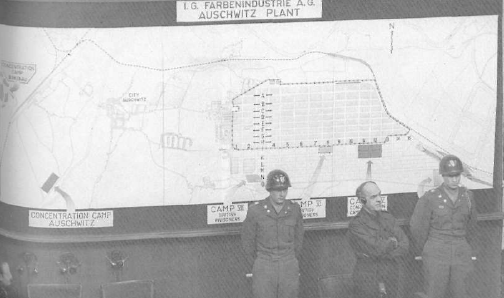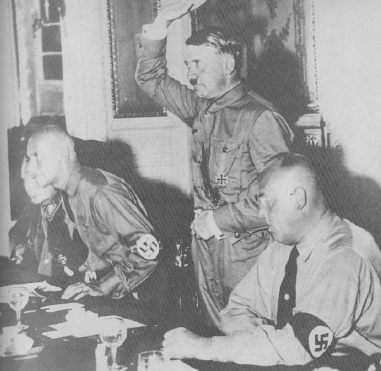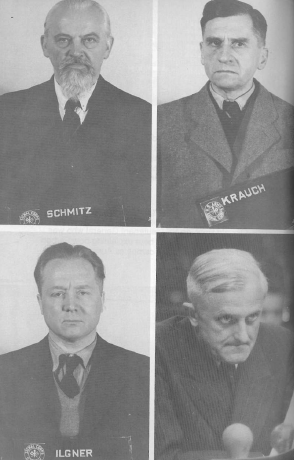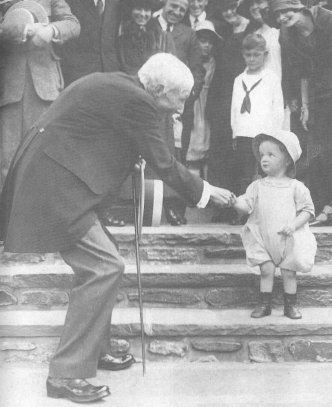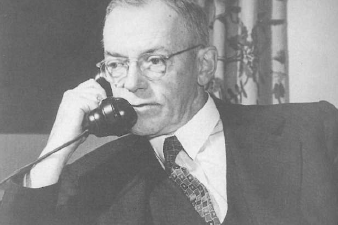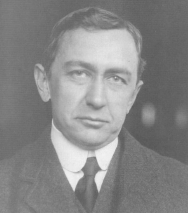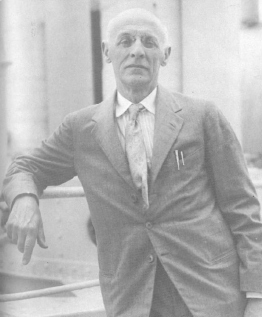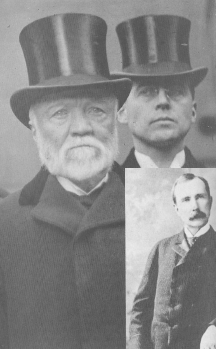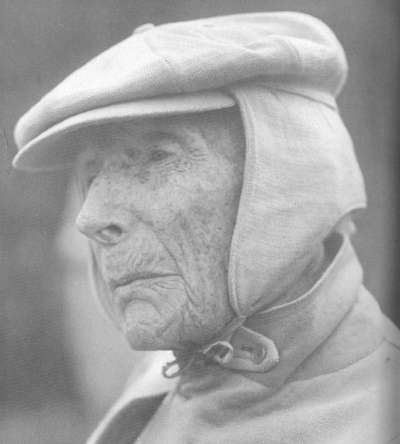|
Chapter Seventeen
Their patriotism is directed toward the giant multi-national
industrial and financial organizations that protect and sustain
them.
1. "Snake Oil From the Oil Companies," Consumer Reports, Feb. 1974,
p. 126.
His advertising posters read:
"Doc" Rockefeller was a con artist. He cheated anyone and everyone
any time he could - and boasted of it. In 1844 he was accused of horse
theft. He had been suspected of bigamy. And in 1849, he was accused
of raping the hired girl in the Rockefeller household. To avoid
prosecution, Big Bill moved to Oswego, outside the court's
jurisdiction.(2)
He said:
1. John T. Flynn, God's Gold; The Story of Rockefeller and His
Times, (New York: Harcourt Brace and Co., 1932), p. 53.
What were these principles and methods of business that John D. learned from his father?
Biographer, John T. Flynn, in his book God's Gold; The Story of Rockefeller and His Times, provides the answer:
And make 'em sharp, he did - especially John D. who went on to become
one of the most ruthless and most successful monopolists of all
time.
1. Flynn, op. cit., p. 58.
The ascendancy of the Rockefeller empire is proof of the success of that plan. John D., Sr., had a number of close business associates.
Some originally were partners. Most were defeated rivals who had been brought into the structure. These men became multi-millionaires, and most of their descendants have remained closely linked with the Rockefeller family. Whether intermarriages were arranged as "unions of convenience," as were common among the ruling classes of Europe, or were the result of romance, the result has been the same.
The Rockefeller biological (and stockholder)
strain has intermingled in an almost unbroken line through half of
the nation's wealthiest sixty families and back again. Throughout it
all, the aggregate is controlled, economically at least, by the one
family that is the descendant of John D. Rockefeller, Sr.
The many "independent" companies that
resulted continued to be owned - and in many cases even run - by the
same men. None of them ever engaged in serious competition between
themselves, and certainly not against Standard Oil of New Jersey,
which continued to be Rockefeller's main holding company.
These companies control a staggering maze of subsidiaries that operate in almost every nation of the world. All together, Standard Oil of New Jersey admits to outright control over 322 companies.(1)
1. Hoffman, op. cit., pp. 151, 152.
In addition, Rockefeller
established cartel links through investments in many foreign
"competitors." These included Royal Dutch (Shell Oil) and a half
interest in the Soviet Nobel Oil Works.
Later, the family
of John D. Rockefeller moved most of its financial interests to a
bank of their own, but the descendants of William Rockefeller
became, and continue to be, the majority shareholders in the First
National City Bank, which eventually became one of the largest
financial institutions in the world.
Meanwhile, the International Acceptance Corporation, a bank
owned by Kuhn, Loeb and Company, had merged into the Bank of the
Manhattan Company. And it was this that was absorbed in 1955 by the
Rockefeller's Chase National Bank resulting in the largest banking
firm in the world: The Chase Manhattan.
We do know, however, that it is more like a sovereign state than a business firm. It has far more money than most nations. It has over fifty-thousand banking officers serving as ambassadors all around the world. It even employs a full-time envoy to the United Nations, for whom it serves as banker.(1)
1. The U.N. always has been a pet project of the Rockefeller family.
They donated the land on which the U.N. building now stands. It's
likely that they view the U.N. as the ultimate mechanism for the
enforcement of monopoly power throughout the entire world, a role
for which it is admirably structured.
Before 1933, banks in the United States operated in
two areas of activity. They handled the commercial checking accounts
and deposits of individuals and corporations, an area of activity
known as commercial banking. They also represented clients who were
buying or selling stocks and bonds in various corporate enterprises,
an area of activity known as investment banking.
The
banks complied, but the result was not what the voters had in mind.
Separate investment banking firms were established, but they were
owned by exactly the same people who also owned the commercial
banks. As a result of the mergers that took place in the wake of
this legislation, there were fewer firms, and thus, greater
concentration of power than ever before.
With the formation of the First Boston Corporation, the powerful Mellon family threw in its lot with the Rockefeller family, and the only substantial block that was not yet united into the monolithic banking structure was the family of J.P. Morgan, although they cooperated in many joint projects, including formation of the Federal Reserve System.(1)
1. Contrary to popular belief, the Federal Reserve System - the entity
that controls the creation of money in the United States - is neither
owned nor run by the government. It is a cartel comprised of the
banking interests that are the subject of these passages. For the
complete story, see The Creature from Jekyll Island: A Second Look
at the Federal Reserve by G. Edward Griffin, (Westlake Village, CA:
American Media, 1995).
Switzerland, in spite of the unique role it plays because
of its bank secrecy and numbered accounts, cannot compare with
the money volume and power centered in the United States. Even
London, which was the wellspring of financial power through the
Rothschild and Morgan empires, has since fallen to second place.
While it is true that a great deal of
foreign
money does find its way into Swiss banks, there still is more
money and real wealth inside the United States than in most of the
rest of the world combined. Furthermore, a substantial portion of
this wealth is concentrated into the hands of the financial and
industrial cartelists in New York.
1. Lundberg, The Rich and the Super Rich, op. cit., p. 461.
About half of
this, in turn, is held in trust by the ten leading Wall Street
banks, which, in turn, are heavily influenced, if not controlled
outright, by a group so small that they could be counted on the
fingers of one hand. This, stated in plain English, represents the
greatest and most intense concentration of wealth and power that the
world has ever seen.
Each of these factors may
have played a small part in the process, but to whatever extent they
did, it was infinitesimal compared to the larger role played by the
guaranteed super profits that resulted from simply eliminating the
competition.
But how?
The profits of control are derived
from such things as inside information that makes it possible to
anticipate movements in the stock market, attractive stock options,
handsome fees for consultation, commissions and royalties from
crossbreeding contracts with affiliated companies, rnultimillion
dollar loans at artificially high or low interest rates (depending
on the direction of the advantage), and similar devices.
1. This is the unanimous opinion of experts in the field of high
finance. See the New York Times, Nov. 7,1955; also Lundberg, op.
cit., p. 270; also Hoffman, op. tit., pp. 6, 7; and others.
They include all the usual tricks of business - such as proxy battles and social pressure on members of the board - plus most of the tactics of all-out war as well. They also include use of hidden allies from other countries who may own small but substantial blocks through numbered accounts in Swiss banks.
But
the greatest weapon of all is the powerful leverage they can obtain
through their control of large blocks of stock that are held
indirectly by them as part of the investment portfolios of the
financial institutions they also control.
They belong to the policyholders. Nevertheless, the minority who control the company exercise the right to vote that stock just the same as if they owned it. In this way, a few people in control of a financial institution can multiply their influence by a factor hundreds of times greater than their own capital investment would suggest. They also can influence the price of the stocks they hold merely by buying or selling huge blocks of them. The profit potential of controlling and anticipating such transactions is enormous.
This is the "magic" of investment banking, and it explains
why the leaders of Wall Street's great financial cartels are,
historically, at the summit of the industrial empires of the United
States.
In addition to the billions of dollars worth of other people's industrial stocks which it controls through the trust departments and trust companies affiliated with its commercial banking operations; in addition to the billions controlled in the same way through its investment banking firms; and in addition to the megalithic blocks of stock held in trust by the various Rockefeller foundations; it also has control over the vast stock holdings of both the Metropolitan and Equitable life-insurance companies, the first and third largest in the United States.
The
Traveler's and Hartford insurance companies, likewise, came under
Rockefeller control largely through its chief executives, such as J.
Doyle DeWitt and Eugene Black, both directors of the Chase Manhattan
Bank.
In the field of drugs and pharmaceuticals, the Rockefeller influence is substantial, if not dominant. When David Rockefeller spoke before the Investment Forum in Paris, he said that it was wise to invest in,
1. Hoffman, op. cit., p. 185.
That he has followed his own advice is a matter of record.
One is the fact that, for many years before World War II, Standard Oil had a continuing cartel agreement not to enter into the broad field of chemicals except as a partner with I.G. Farben which, in turn, agreed not to compete in oil. The other is that, because of the unpopularity of Farben in this country and its need to camouflage its American holdings, Standard had concealed even its partnership interests in chemical firms behind a maze of false fronts and dummy accounts.
The Chase Manhattan Bank, however, has been the principal stock registrar for Farben-Rockefeller enterprises such as Sterling Drug, Olin Corporation, American Home Products, and General Analine and Film.
When Farben's vast holdings were finally sold in 1962, the Rockefeller group was the dominant force in carrying out the transaction.
One may assume, therefore, that, if there was any way
to benefit from inside information or to place a minority into a
position to reap the profits of control, the Rockefeller group did
so. Consequently, it is difficult for an outsider to separate the
pure Rockefeller control from that which is shared by I.G. Farben or
its descendants. That it constitutes a major power center within the
pharmaceutical industry, however, cannot be denied.
Profits can be
extremely high - not for the physician or the druggist - but for the
firms that manufacture the drugs.
Consequently, prices can be
raised without consumer complaint. (Never mind that the cost
eventually must be paid by the consumer, either in higher insurance
premiums or higher taxes.) And so this is merely another example of
using the power of government to eliminate competition and increase
costs to the consumer.
Although many
otherwise well informed persons are totally unaware of it, cartels
do exist. They have completely dominated the chemical industry for
decades. The pharmaceutical industry, far from being exempt from
this influence, has been at the center of it from the beginning. We
are traveling this long path of historical inquiry for the reason
that one simply cannot evaluate the broad opposition to vitamin
therapy without an awareness of this cartel.
Yet, the American people generally do not consider the Rockefellers to be that important.
As Ferdinand Lundberg observed:
1. Lundberg, op. cit., p. 21.
Perhaps the reason Americans do not regard the Rockefellers as the "Brobdingnagian commissars" that they really are is because, like their Farben counterparts in Nazi Germany, they have wisely chosen to stay in the background.
They are seldom in the news and are overshadowed by the public appearances and pronouncements of the nation's politicians.
The men who sit at the pinnacle of this world
power prefer to leave the publicity-seeking to their political
subordinates who, by temperament, are more suited to the task. The
amount of power held by a John or a David Rockefeller may not be as
great as that held for a single moment by a president of the United
States. By comparison, however, the president is but a passing comet
streaking toward oblivion.
But the power of the Rockefellers is handed down from generation to generation as a title of nobility and has become a living, growing, nearly immortal reality of its own.
(above) I.G. Farben, the world's largest chemical and drug cartel, was headquartered in this building in Frankfurt, Germany. It became the backbone of the Nazi war machine.
Yet, during the massive
bombing raids on Frankfurt, American bombardiers were instructed to
spare this building. It survived without a scratch.
U.S. Army photo
Adolph Hitler (above) at a 1932 meeting in Berlin.
Hitler's rise to
power would have been impossible without the secret financial
support of
I.G. Farben. The Nazi state became the means by which
cartel agreements were enforced.
Max llgner, Farben's "Director of Finance," in reality was in charge of espionage and propaganda.
Otto Ambros (bottom right) was production chief of Farben's poison-gas facilities, (U.S. Army photos)
John D. Rockefeller, Sr. (above), often gave away shiny dimes to small children at public gatherings in an attempt to improve his image in the press.
This device was suggested by Ivy Lee (below), one of the world's foremost public-relations experts. Mr. Lee also had been retained by I.G. Farben to appraise the public-image Potential of Adolph Hitler.
Salter Teagle (above, left), while president of Standard Oil, Secretly held stock in Farben enterprises on behalf of the Rockefeller family.
Through such ploys, the Rockefellers have obscured their financial interest in the field of drugs.
Abraham Flexner (above left), author of the famous Flexner Report of 1910, led the crusade for upgrading the medical schools of America.
All the while, he was in the employ of
Andrew Carnegie (above right)
and John D. Rockefeller who had set up tax-exempt foundations
for that purpose.
John D. Rockefeller, Sr., shown here at age 93, had created fantastic wealth.
When he interlocked his own empire with that of I.G. Farben in 1928, there was created the largest and most powerful cartel the world has ever known. Not only has that cartel survived through the years, it has grown an prospered.
Today it plays a major
role in both the science and politics of cancer therapy.
Back to Rockefeller Internationalism
|

